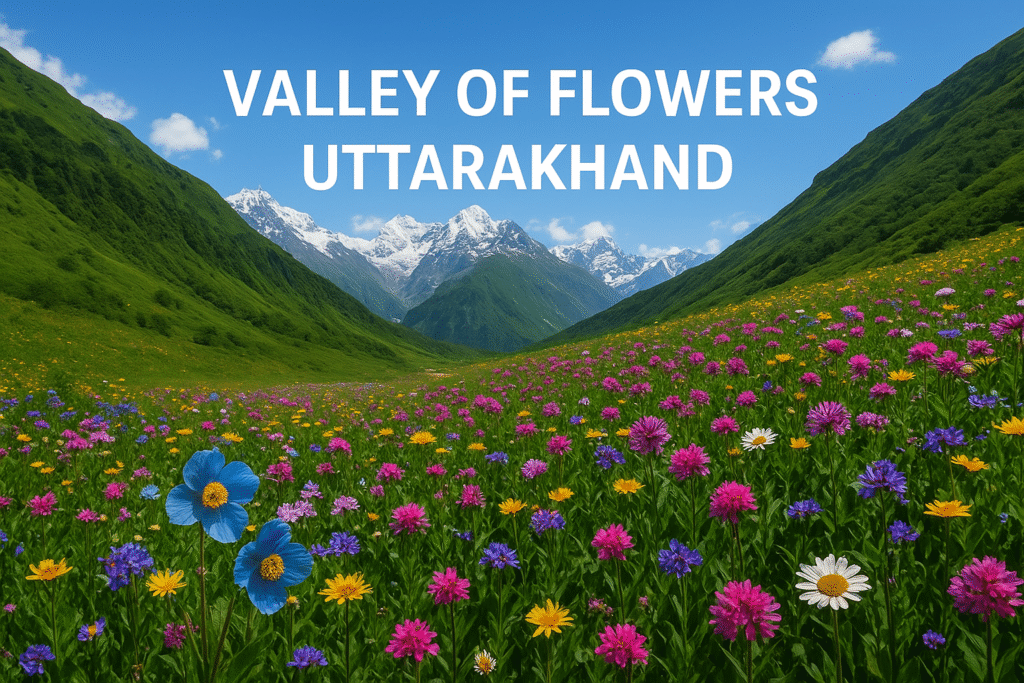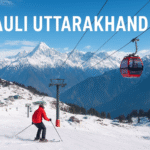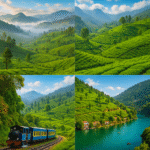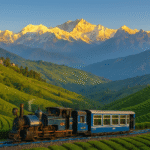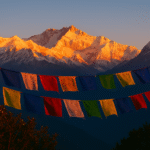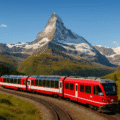High in the Garhwal Himalayas lies one of India’s most stunning natural treasures — the Valley of Flowers National Park. Spread across 87 square kilometers at an altitude of 3,600 meters, this UNESCO World Heritage Site is famous for its colorful meadows, snow-clad mountains, and rare wildlife. Moreover, every monsoon season, the valley transforms into a breathtaking carpet of flowers, making it one of the most visited trekking destinations in Uttarakhand.
💡 Travel Tip
Plan your journey between mid-July and early September to witness the valley at its peak bloom.
📍 Location and How to Reach
The valley is located in Chamoli district, Uttarakhand, around 300 km from Rishikesh. The journey starts from Govindghat, a small town on the Badrinath highway. From there, you can trek 13 km to Ghangaria, which serves as the base village. Finally, a shorter 3 km trek from Ghangaria takes you directly into the valley.
In addition, helicopter services and ponies are available for those who want to avoid the long uphill walk. However, trekking remains the most rewarding way to experience the route.
💡 Travel Tip
Download offline maps before leaving Govindghat because mobile signals are weak in the region.
🌼 History and Discovery
For centuries, locals believed the valley to be home to divine spirits and medicinal herbs. However, the world only came to know of it in 1931, when British mountaineer Frank S. Smythe and his team discovered it while returning from Mount Kamet. Smythe later described its magical beauty in his book The Valley of Flowers.
Later, the Indian government declared it a National Park in 1982, and UNESCO recognized it as a World Heritage Site in 2005. Since then, it has drawn global attention as one of the most beautiful trekking destinations in the Himalayas.
💡 Travel Tip
Read Smythe’s book before your trip; it will help you appreciate the valley even more.
🌺 Flora – The Heart of the Valley
The Valley of Flowers is home to more than 500 species of plants, many of which are rare and endangered. As the season changes, so does the valley’s color palette. First come primulas and daisies in June, followed by blue poppies, orchids, and anemones in July. By August, the meadows explode with brahma kamal, cobra lilies, and geraniums.
Not only does the valley provide beauty, but it also holds medicinal importance. Several alpine herbs found here are still used in traditional healing practices. Therefore, the valley serves both as a natural wonder and a scientific treasure.
💡 Travel Tip
Hire a local guide or carry a flower handbook to identify rare species during your trek.
🦌 Wildlife and Birdlife
In addition to its colorful flowers, the valley is home to diverse wildlife. You may spot musk deer quietly grazing or Himalayan blue sheep running along the cliffs. Red foxes, Himalayan black bears, and even snow leopards live here, though sightings are rare.
Bird lovers will also find joy in spotting the Himalayan Monal, Golden Eagle, and Snow Partridge. Because of the valley’s remoteness, many bird species thrive here without human interference.
💡 Travel Tip
Carry binoculars and remain silent to increase your chances of spotting rare animals.
🌄 Trekking Route and Difficulty
The trek to the Valley of Flowers is considered moderate. Although it does not require advanced skills, stamina and preparation are important.
- Govindghat to Ghangaria: 13 km trek along the Pushpawati River.
- Ghangaria to Valley of Flowers: 3 km trek, with gradual ascent.
- Bonus trek to Hemkund Sahib: 6 km steep climb to a Sikh pilgrimage site beside a glacial lake.
Therefore, most travelers spend at least 4–5 days completing the trip comfortably.
💡 Travel Tip
Start your trek early in the morning. Clouds often cover the valley by afternoon.
🏞 Best Time to Visit
The Valley of Flowers opens from June to October. Each month offers a slightly different experience:
- June: Snow melts, and fresh buds begin to bloom.
- July–August: Full bloom season with the most vibrant colors.
- September: Fewer tourists and clear skies.
- October: End of the season; flowers fade, but landscapes stay majestic.
Consequently, your choice of month depends on whether you want to see flowers in full bloom or enjoy peaceful treks with fewer visitors.
💡 Travel Tip
For photography and vibrant flowers, late July is the perfect time.
🙏 Mythology and Spiritual Significance
The valley is not just about natural beauty; it also carries deep spiritual meaning. According to Hindu mythology, Lord Hanuman picked the Sanjeevani herb from this region to save Lakshmana’s life in the Ramayana.
Additionally, just 6 km above Ghangaria lies Hemkund Sahib, a Sikh shrine located by a glacial lake at 4,329 meters. It is believed that Guru Gobind Singh meditated here in a previous life. Thus, the Valley of Flowers combines natural wonders with divine legends.
💡 Travel Tip
Include Hemkund Sahib in your itinerary for a complete spiritual and natural experience.
🌍 Rules and Conservation
Since it is a UNESCO World Heritage Site, strict rules are enforced to protect its fragile ecosystem:
- No camping inside the valley.
- No littering or use of plastic.
- No plucking of flowers or disturbing wildlife.
- Entry is allowed only during daytime with permits.
Therefore, travelers must follow guidelines carefully to help preserve this paradise for future generations.
💡 Travel Tip
Buy your entry permit at Govindghat or online in advance to save time.
✅ Essential Travel Tips
🥾 Trekking and Fitness
The trek is manageable but requires preparation.
💡 Travel Tip
Carry trekking shoes, a walking stick, and stay hydrated.
☔ Weather and Clothing
Weather changes quickly in the Himalayas.
💡 Travel Tip
Wear layers and pack a raincoat or poncho.
💧 Health and Safety
Altitude sickness can affect beginners.
💡 Travel Tip
Ascend slowly and keep medicines like Diamox if needed.
🏨 Stay and Food
Accommodation is only available in Ghangaria.
💡 Travel Tip
Book your guesthouse early, especially in peak season.
📸 Photography
The valley is a photographer’s dream.
💡 Travel Tip
Visit in the morning for soft light and clear skies.
Valley of Flowers Uttarakhand – FAQs
1. Is the Valley of Flowers trek difficult?
The trek is considered moderate in difficulty. Although the trail is not very steep, it requires stamina because of long walking hours. With proper preparation and fitness, beginners can also complete it.
2. What is the best time to visit Valley of Flowers?
The best time to visit is July to September, when the valley is in full bloom. During these months, you’ll see a vibrant carpet of flowers after the monsoon rains.
3. Do I need a permit for the Valley of Flowers trek?
Yes, visitors must obtain an entry permit at the park gate in Ghangaria. The fee is usually valid for three days and is required for all Indian and foreign tourists.
4. How do I reach Valley of Flowers?
To reach, travel by road to Govindghat from Rishikesh or Haridwar. From there, trek to Ghangaria, the base village, and continue on foot into the Valley of Flowers.
5. Can I visit Hemkund Sahib along with Valley of Flowers?
Yes, most trekkers combine both. From Ghangaria, it’s a steep trek of about 6 km to Hemkund Sahib, a famous Sikh pilgrimage site with a stunning glacial lake.
6. What should I pack for the trek?
Carry trekking shoes, rain gear, warm clothes, walking stick, reusable water bottle, and energy snacks. Since the weather changes quickly, layers are essential.
7. Is camping allowed inside Valley of Flowers?
No, camping is not permitted inside the valley. Visitors must stay at Ghangaria and make day trips to explore the national park.
Conclusion
The Valley of Flowers Uttarakhand is more than just a trek. It is a journey into a magical landscape where blooming meadows meet snow-capped peaks and spiritual legends blend with natural wonders. As a result, every traveler returns with unforgettable memories and a renewed love for the Himalayas.
💡 Final Travel Tip
Spend at least two days in Ghangaria — one for the valley and another for Hemkund Sahib — to enjoy the region fully.
